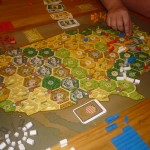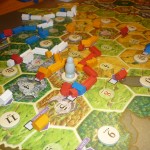Catan Game Opens the Old West
Our family enjoys board games from time to time, especially old standards like Monopoly, Clue, and Scrabble. We also enjoy history, geography and trains. Our friends at Timberdoodle sent us a board game that combines them all, and we’ve added a new game to our list of favorites!

Settlers of America: Trails to Rails is made by the developers of the Settlers of Catan series. The game is designed for three or four players, and the massive game board makes it easy to play as teams (we pair younger players with older ones like, ahem, me). Like the original Catan, the concept is fairly simple — players start in the eastern U.S. and settle their way to the Pacific. Players start at existing cities, send settlers to found new ones, then build railroads along the wagon trails to transport goods from place to place. Settled territories produce resources of wood, cattle, grain, ore and coal which supply further expansion.
There are some interesting facets of the game. For one thing, while money and resources are used in the game, accumulation of wealth isn’t the goal – you win by delivering goods to a certain number of cities. You have to gather resources to expand. Settlers need cattle, grain and wood, reasonably enough. Moving a wagon requires grain (fuel for the ox). Trains need coal, on the other hand, and tracks require ore (for the steel rails) and wood (for crossties). Very logical and straightforward. There are some surprises built in which prevent too much stockpiling along the way, and the resource cards stay in pretty constant circulation.
 We enjoyed the way the game unfolded. Every turn starts with “production,” where every player collects the resources found near his cities – so every player is involved at every turn. More cities equals more resources, but you have to be strategic where you settle; I ended up with loads and loads of coal, but a permanent dearth of cattle. The hexagonal territories roughly correspond to states and regions of the U.S., with more grain in the midwest, coal in Appalachia and regions of the west, wood in the south and pastureland around Kentucky and so forth, so you get a general feel for regional products. City locations are approximate, being determined by the honeycomb pattern of the trails, but close to reality in a general way. Trading, movement, and building follow production, and the network of rails and cities spreads gradually across the country.
We enjoyed the way the game unfolded. Every turn starts with “production,” where every player collects the resources found near his cities – so every player is involved at every turn. More cities equals more resources, but you have to be strategic where you settle; I ended up with loads and loads of coal, but a permanent dearth of cattle. The hexagonal territories roughly correspond to states and regions of the U.S., with more grain in the midwest, coal in Appalachia and regions of the west, wood in the south and pastureland around Kentucky and so forth, so you get a general feel for regional products. City locations are approximate, being determined by the honeycomb pattern of the trails, but close to reality in a general way. Trading, movement, and building follow production, and the network of rails and cities spreads gradually across the country.
There are some unexpected lessons, too. For one thing, you see why parallel rail lines developed across the wilderness; there are rewards for being the first to connect a new city, and costs for using other players’ rails en route. I found myself sitting back at several points with a real-life problem, balancing the resources on hand, possible routes of expansion, and weighing the real possibility of sudden calamity that could undermine my next move. Still, the game isn’t cut-throat like Monopoly, focusing on the race to provide services and goods rather than plotting to bankrupt your opponents.
The first time I played it, one of the older boys explained the rules (he’d played it for the first time the week before). Catan’s website has a helpful tutorial, “Professor Easy’s Quick Guide,” which may speed your set up the first time through.
Catan’s other games have an avid following, and I can see why. This is a good, thoughtful way to spend a rainy afternoon or a weekend evening – it took about three hours for four players to finish. Our crew gives Settlers of America: Trails to Rails a solid eight thumbs up.
(We tested with players aged 13 and up, but younger players enjoyed it in team play. Warning: There are about 280 pieces and 119 cards involved, so you’ll need to keep an eye on toddlers. A good jostle will scramble the game but good!)